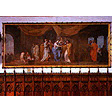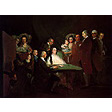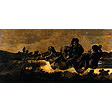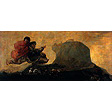
Goya's stylistic development







 |
Goya's stylistic development was not a conventional one. He excelled in the late Baroque and Rococco styles in his youth, but he never fully incorporated the influence of Neo-Classicism which was predominant in Spain and Europe in the final decades of the18th century and the beginning of the 19th. Goya was an artist ahead of his time, who created works full of personality, both in painting and in engraving without ever conforming to the conventional. In effect, he predicted the predominant movements of the 19th and 20th century. Romanticism, Impressionism, Expressionism and Surrealism were the principal movements to be influenced by his work.
Goya was pictorially trained within the confines of the late Baroque and Rococco styles, as can be seen in the work produced in his youth. His journey to Italy brought him to into contact with the prevailing pictorial styles of Classicism and Neo-Classicism, the influences of which can be seen in some of his work on the Carthusian monastery of Aula Dei in Zaragoza. At Court he used different styles. In the tapestry cartoons, the Rococco was predominant when dealing with subjects full of joy and vivacity. He allowed the new winds of Neo Classicism to influence him in some of his religious and mythological works, but he felt uncomfortable with the new style which was becoming increasingly fashionable. He decided to follow his own aesthetic sensibilities. In his old age he stated that his masters were Velazquez, Rembrandt and Nature. In the portraits and other works, the influence of Velazquez can be seen in Goya's treatment of space, light and staining techniques. This tendency became more and more pronounced to an almost impressionistic degree, from 1800 onwards. Goya's portraits, direct, psychological and realistic, renewed the genre. Etching and aquatint were the predominant types of engraving used by Goya in which he created a series of works which were inspired by his personality and imagination. In the Caprichos fantasy and realism combined to produce a savage, daring social critique. Crude and desolate realism dominate The Disasters of War. The world of the subconscious blossomed in the mysterious, impactful images of the Black Paintings, painted in the Quinta del Sordo in Madrid. These images were to be appreciated years later by Expressionists and Surrealists as precursors of their movements. Arturo Ansón |
|
| The Betrothal of the Virgin (Cartusiahn Monastery of Aula Dei) |  |
|
| Family of Infante Don Luis of Bourbon |  |
|
| The dream of reason brings forth monsters |  |
|
| Bitter presence |  |
|
| Atropos or The Fates |  |
|
| Phantastic vision or Asmodea |
 |
InfoGoya 96 is an initiative of the University of Zaragoza, sponsored by the Institution Fernando el Católico of the Deputation of Zaragoza on an Apple Internet Server donated by Apple Computer. |    |